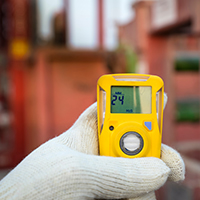 As metro areas seemingly grow exponentially, there is a considerable industry need to provide field technicians with accurate locational and asset data, as well as reduce errors stemming from redundant manual entry processes. CoServ and Starboard Consulting recently partnered to develop a leak survey tracking solution that integrates GIS and Maximo, and which offers significantly more intelligent asset management with spatially enabled data.
As metro areas seemingly grow exponentially, there is a considerable industry need to provide field technicians with accurate locational and asset data, as well as reduce errors stemming from redundant manual entry processes. CoServ and Starboard Consulting recently partnered to develop a leak survey tracking solution that integrates GIS and Maximo, and which offers significantly more intelligent asset management with spatially enabled data.
Amy Tatum, Solutions Director with Starboard Consulting, recently joined Jason Dietrich, SDE Administrator with CoServ Electric and Gas, to discuss in more detail below how their gas leak tracking enterprise solutions integrate GIS with Maximo. Together, Amy and Jason have a combined 30 years of industry experience.
Q: Why integrate GIS and Maximo instead of continuing to use them separately?
A: Jason: For CoServ, the need for better GIS and Maximo integration arose from the problems occurring with historical leak survey tracking records. Like many in the industry, our Gas Division’s leak surveys were being performed “the old fashioned way.” A field technician took a paper map out to the field and marked detected leaks on the map as they were discovered, and then the survey data would later be manually entered into the database at the office. Located outside Dallas-Ft. Worth, our area was experiencing tremendous growth with new subdivision developments breaking ground seemingly daily and the paper maps were quickly outdated. This compounded the problem even further. We knew we needed an enterprise solution that better utilized GIS to capture leak information.
A: Amy: Starboard had already been engaged with CoServ for several Maximo roadmap and Maximo implementation solutions for electric construction work management and GIS asset visualization. Building on the standards and processes designed for electric, we were confident we could replace the legacy work management system into an enterprise-wide approach that would provide better asset management, preventative maintenance, and regulatory compliance. Integrating Maximo with GIS was the logical choice for more accurately capturing the leak data.
Q: Why isn’t keeping meticulous records, regardless if they are kept manually or in separate software systems enough?
A: Jason: Beyond being outdated, field technicians using paper maps may be missing critical infrastructure that needs to be surveyed for compliance. Additionally, when the technician either wrote in or called in a leak, this process created a redundant manual entry, possibly from multiple users, which increases the risk of errors during every manual data entry. We also found that along with the issue of multiple manual records, coupled with the growth of the service area, errors compounded and snowballed, affecting every department to the point that it was becoming almost unmanageable.
Q: How did you begin to tackle this dilemma?
A: Amy: It was a collaborative effort, enabling Maximo and GIS to do what they do best and combining or integrating their strengths. For example, in this instance, Maximo is utilized for maintenance and inspection schedules, using the native Preventive Maintenance and Work Order applications to track when surveys need to be performed, including the required frequency, last completion date, assignment and scheduling information, and any resulting repair history and asset details.
A: Jason: And while Maximo excels at handling those tasks, GIS was the logical choice for capturing the leak information. Esri was kind enough to demo the Leak Survey Suite to our IT-GIS and gas operations personnel. It was an eye-opening experience viewing the capabilities of Collector. The ability to display critical infrastructure and how it relates to leaks is a valuable asset in the inspection and collection process. Not to mention that it allows technicians to pinpoint the locations of the leaks with Spatial.
Q: Does this integration offer a seamless workflow between Maximo and GIS?
A: Amy: Yes. The workflow initiated in Maximo with the preventive maintenance records triggers a system process to generate a new leak survey inspection work order.
A: Jason: Maximo then sends a message to the GIS to update the gas system feature with the current inspection work order number. This is important to maintain linkage to the features and the resulting leak points. Field crews use the Collector application to record progress on the inspection and note any problem areas found. Where possible leaks are discovered, a point is placed on the map and becomes a record in the gas leak feature class.
A: Amy: Creation of a record in the leak feature class triggers a process in Maximo to create a corresponding leak repair work order. The resulting solution is also serving as proof of concept for future applications to migrate data with similar workflows.
Want to learn more? Contact info@starboard-consulting.com at Starboard Consulting to maximize your asset management technology.
Starboard is a full-service provider of assessments, implementations, upgrades, integration, training, and support for a wide variety of enterprise asset applications. Starboard is also recognized nationally as an IBM Gold Partner and Esri Silver Partner. CoServ is an electric and gas distribution provider that serves North Texas. CoServ serves more than 250,000 electric meters, over 125,000 gas meters, and is quickly growing with the addition of more than 1,500 meters per month.
